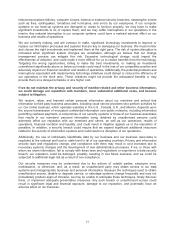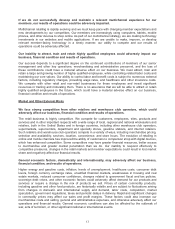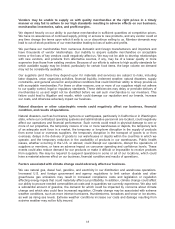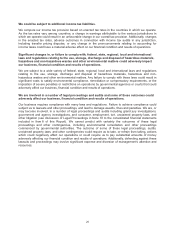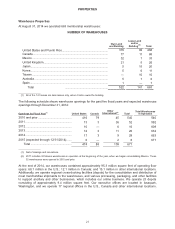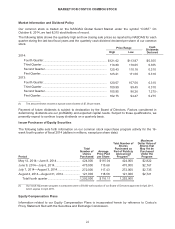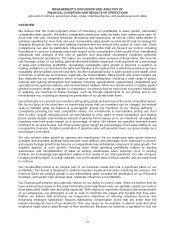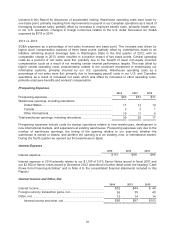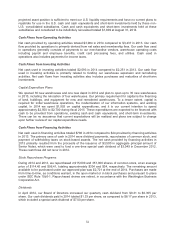Costco 2014 Annual Report Download - page 27
Download and view the complete annual report
Please find page 27 of the 2014 Costco annual report below. You can navigate through the pages in the report by either clicking on the pages listed below, or by using the keyword search tool below to find specific information within the annual report.MANAGEMENT’S DISCUSSION AND ANALYSIS OF
FINANCIAL CONDITION AND RESULTS OF OPERATIONS
(amounts in millions, except per share, share, membership fee, and warehouse count data)
OVERVIEW
We believe that the most important driver of increasing our profitability is sales growth, particularly
comparable sales growth. We define comparable warehouse sales as sales from warehouses open for
more than one year, including remodels, relocations and expansions, as well as online sales related to
websites operating for more than one year. Comparable sales growth is achieved through increasing the
shopping frequency from new and existing members and the amount they spend on each visit. Sales
comparisons can also be particularly influenced by two factors that are beyond our control, including
fluctuations in currency exchange rates (with respect to the consolidation of the results of our international
operations) and changes in the cost of gasoline and associated competitive conditions (primarily
impacting domestic operations). The higher our comparable sales exclusive of these items, the more we
can leverage certain of our selling, general and administrative expenses, reducing them as a percentage
of sales and enhancing profitability. Generating comparable sales growth is foremost a question of
making available to our members the right merchandise at the right prices, a skill that we believe we have
repeatedly demonstrated over the long term. Another substantial factor in sales growth is the health of the
economies in which we do business, especially the United States. Sales growth and gross margins are
also impacted by our competition, which is vigorous and widespread, including a wide range of global,
national and regional wholesalers and retailers, including supermarkets, supercenters, department and
specialty stores, gasoline stations, and internet-based retailers. While we cannot control or reliably predict
general economic health or changes in competition, we believe that we have been successful historically
in adapting our business to these changes, such as through adjustments to our pricing and to our
merchandise mix, including increasing the penetration of our private label items.
Our philosophy is to provide our members with quality goods and services at the most competitive prices.
We do not focus in the short term on maximizing prices that our members can be charged, but instead
seek to maintain what we believe is a perception among our members of our “pricing authority” –
consistently providing the most competitive values. Our investments in merchandise pricing can, from
time to time, include reducing prices on merchandise to drive sales or meet competition and holding
prices steady despite cost increases instead of passing the increases on to our members, all negatively
impacting near-term gross margin as a percentage of sales. We believe our gasoline business draws
members to our warehouses, but it has a lower gross margin as a percentage of net sales relative to our
non-gasoline business. A higher penetration of gasoline sales will generally lower our gross margin as a
percentage of net sales.
We also achieve sales growth by opening new warehouses. As our warehouse base grows however,
available and desirable potential sites become more difficult and potentially more expensive to secure,
and square footage growth may become a comparatively less substantial component of sales growth. The
negative aspects of such growth, including lower initial operating profitability relative to existing
warehouses and cannibalization of sales at existing warehouses when openings occur in existing
markets, are increasingly less significant relative to the results of our total operations. Our rate of square
footage growth is higher in foreign markets, due to the smaller base in those markets, and we expect that
to continue.
Our membership format is an integral part of our business model and has a significant effect on our
profitability. This format is designed to reinforce member loyalty and provide continuing fee revenue. The
extent to which we achieve growth in our membership base, increase the penetration of our Executive
members, and sustain high renewal rates, materially influences our profitability.
Our financial performance also depends heavily on our ability to control costs. While we believe that we
have achieved successes in this area historically, some significant costs are partially outside our control,
most particularly health care and utility expenses. With respect to expenses relating to the compensation
of our employees, our philosophy is not to seek to minimize the wages and benefits that they earn.
Rather, we believe that achieving our longer-term objectives of reducing employee turnover and
enhancing employee satisfaction requires maintaining compensation levels that are better than the
industry average for much of our workforce. This may cause us, for example, to absorb costs that other
employers might seek to pass through to their workforces. Because our business is operated on very low
25


